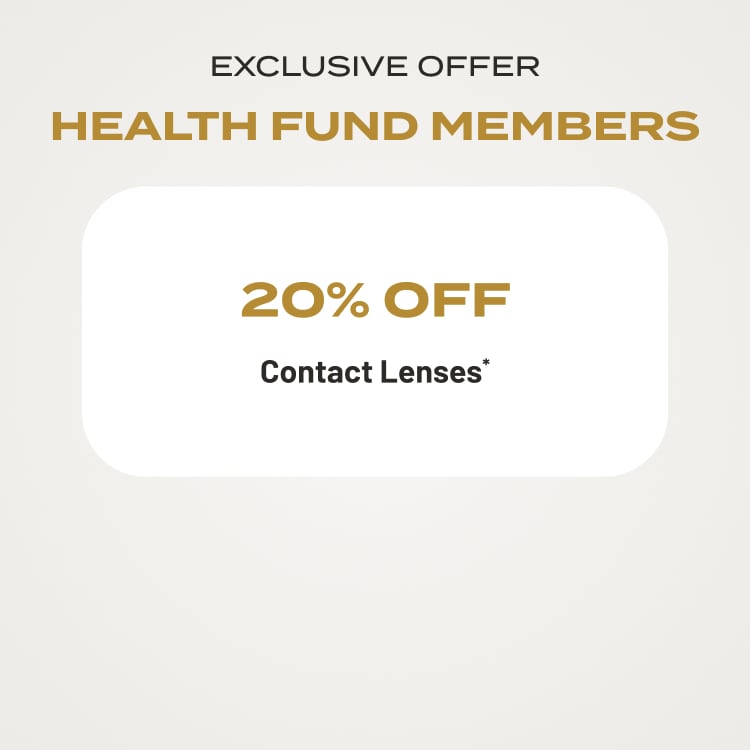-
Contact lenses
Type and Frequency
Daily Fortnightly Monthly Toric Multifocal
Brand
Acuvue Dailies Biofinity OPSM View all brands
Solutions & Accessories Subscribe & Save 25%Reorder your contacts View all contacts
 Shop now
Shop now^Further T&Cs apply.
-
Glasses
Shop by our picks
New Arrivals Best SellersRay-Ban | MetaNewOakley | MetaNew
Shop by offer
Sale | Up to 50% off
Shop by lenses
Transitions®
Shop by brand
Ray-Ban Oakley Miu Miu Versace
Find your Frame VIEW ALL GLASSES
 Shop now
Shop now*In store only. When purchased as part of a complete pair (frame and lenses). T&Cs apply.
-
Sunglasses
Shop by our picks
New Arrivals Best SellersRay-Ban | MetaNewOakley | MetaNew
Shop by offer
Seasonal Promo Sale | Up to 50% off
Shop by lenses
Oakley® Prizm™ Lenses
Shop by brand
Ray-Ban Oakley Prada Ralph
Find your Frame VIEW ALL SUNGLASSES
 Shop now
Shop now*In store only. When purchased as part of a complete pair (frame and lenses). Further T&Cs apply.
-
-
Brands
a - z
Alain Mikli Armani Exchange Arnette Brooks Brothers Brunello Cucinelli Burberry Coach Costa Dolce&Gabbana Emporio Armani Ferrari Giorgio Armani GucciJimmy ChooMichael Kors Miraflex Miu MiuNewMonclerOakleyNewOakley MetaOliver Peoples OPSM Persol Polo Ralph Lauren Prada Prada Linea Rossa Ralph Ray-BanNewRay-Ban MetaScuderia Ferrari Sferoflex Swarovski Tiffany & Co. Tom Ford Versace Vogue EyewearNew -
Our Services
BUYING ONLINE
Claim Health Fund Benefits Subscribe & Save 25% Find your frame
OPTOMETRY SERVICES
Book an Eye Test Vision Plan™ Eye Tests Eye Technology
AUDIOLOGY SERVICES
Book a Hearing Test Hearing care
USEFUL INFORMATION
Bulk Billing Workplace Services FAQs Lenses Dedicated to Everyday Excellence



Eye Conditions
Looking for help
You should never miss life’s precious moments, so it’s important to find eye problems early, so we are best prepared to help you. If you recognise any of the following disorders or conditions, please book an eye test or visit an OPSM store and our optometrists will help explain what’s going on and what needs to be done.
KEY FACTS
| Myopia (Short sightedness) | If you can see close objects clearly but have trouble focusing on objects in the distance, you’re probably short sighted or have myopia. You may find it difficult to read signs, watch television or recognise people walking down the street towards you. |
| Hyperopia (Long sightedness) | Your distance vision is good, but you have trouble with closer objects, which appear blurred. Other symptoms include eye fatigue, headaches and aching eyes, especially after reading or working on a computer. Finding it difficult to see characters when texting may also be a sign of hyperopia. |
| Astigmatism (Irregular shaped eye) | Most people don’t have a perfectly shaped cornea. However, an irregularly curved cornea can sometimes cause blurred vision and this is known as astigmatism. This is very common and is not a disease. |
| Presbyopia (Age-related long sightedness) | If you’re over 40 years of age and notice that it’s becoming difficult to read the menu in a low-lit restaurant, or if you have to extend your arms when reading a book or sending a text, you’re probably suffering from presbyopia. This is a natural part of growing older and occurs when your eyes lose their ability to bring close objects into clear focus. |
The chance of developing age-related macular degeneration increases once you’re over 40. It’s the leading cause of blindness in Australia*. There are two types: dry macular degeneration and wet macular degeneration, both affecting your central vision. Wet macular degeneration can lead to more serious vision loss but, if detected early, may be stabilised with treatment. Dry macular degeneration is typically less devastating visually, but cannot be treated.
For most people, cataracts occur naturally through the process of ageing. A cataract clouds the lens of your eye, making it look milky, and the condition becomes worse over time. Symptoms include hazy vision causing blurred or distorted images, colours that appear more yellow and needing more light to see clearly.
Dry eyes occur when your eyes aren’t lubricated enough, the chemical composition of your tears is not balanced or you don’t produce enough tears. It can lead to uncomfortable sensations such as scratchy, itchy or tired eyes. You may also experience burning or red eyes and blurred vision. Strangely enough, dry eyes may sometimes be watery too.
Glaucoma affects your peripheral vision slowly and may not be noticeable until it’s advanced. The disease affects the nerve fibres at the back of your eye. Once the fibres die, you experience loss of vision and, potentially, blindness so it’s really important for us to diagnose this condition early.
A pterygium is a triangular shaped piece of tissue that grows on the white part of the eye, usually close to your nose. It’s not dangerous, but wearing sunglasses and lenses with UV protection will often slow down any further growth.
Almost everyone will notice a few spots in their vision, especially as we grow older. These floating specks are in the fluid of the eye and are usually harmless, unless they suddenly increase in number or size. In that case, please call your nearest OPSM store immediately and book an eye test.
If you’ve been outdoors all day, even if it was cloudy, and your eyes are red and feel painful, you may have sunburn. If you experience changes in your vision after time outside or have sore red eyes, please call us or visit an OPSM store. It’s important to note that not all sunglasses provide the same level of UV protection, with many fashion spectacles offering only some protection from UV rays. Read more about Sunglass Standards.
* Source: Macular Degeneration Foundation, Research Update December 2013















 Book an eye test
Book an eye test
 Health Funds
Health Funds
 Find A Store
Find A Store
 Favourites
Favourites




















